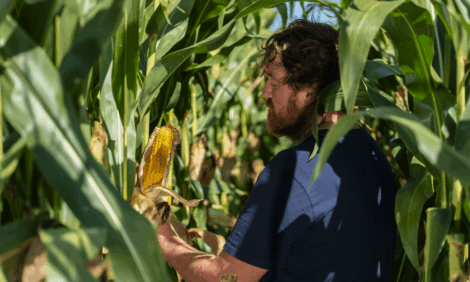



Soil Nitrogen for Efficient Grass Production
Noeleen McDonald was the recipient of the Best Oral Presentation at the Teagasc Walsh Fellowship seminar for her PhD investigation into soil nitrogen supply potential in Irish grassland soilsExisting nitrogen (N) fertilizer recommendations for Irish grassland soils are based on a ‘one soil fits all’ system. This does not consider the varying levels of N that different soils could potentially supply through soil N mineralisation (N0). This may result in under- or over- application of N fertilizers to fields, leading to poorer economic returns and unnecessary losses of N to the environment.
Since 2010, research investigating the soil N supply potential of 28 Irish grassland soils is being conducted at Teagasc, Crops, Environment and Land Use Research Centre, Johnstown Castle. The aim of this research is to investigate the potential for developing a reliable soil test to predict soil N supply in grassland soils. This research has included experiments at laboratory, microcosm and field scales.
Can Soil Tests Predict Soil N Supply Potential?
The ability to make reliable estimates of soil N supply through N mineralisation (N0) has long been a goal for those concerned with N fertiliser management in agricultural systems. In temperate grassland systems, the transient nature of N in the soil causes difficulties for predicting more long-term N supplies for grass uptake. Soil N tests, which measure soil N release resulting from biological activity (i.e., N0), have been shown to be reliable. However, these tests are time-consuming and impractical for routine use. The alternative is to use chemical soil N tests, which are rapid (usually

Furthermore, of all the chemical tests evaluated, the Illinois soil N test (ISNT), measuring amino sugars and NH4 +-N concentrations was found to be the most suitable soil test to predict N0 in these soils.
Grass N Recovery Potential Between Different Soils
These laboratory findings were further evaluated in soil microcosm studies where the 28 soil types were potted, seeded with ryegrass (Lolium perenne L.), and placed in the controlled environment research facility (see photo). These pots received no N fertilizer applications, but were optimised for phosphorus (P), potassium (K) and sulphur (S), as the aim was to quantify the soil N recovery potential by the grass. Grass harvests and soil samples were taken and analysed at five week growth intervals. Large differences were found between these soils in terms of their grass production potential from soil N reserves as shown in Figure 1. Grass dry matter (DM) yield ranged from 845 to 3,133 kg/ha and was tracked closely by N uptake which ranged from 23 to 114 kg N/ha across these soils over the five week growth period. Under these controlled conditions, the influence of climate on N losses was standardised, therefore isolating the soil type-related effects on N supply. The ISNT, by itself, could not accurately predict grass N uptake and DM yield, as it did not account for residual mineral N in the soil profile. However, when the ISNT was combined with a soil mineral N test (to account for this residual mineral N source), grass N uptake for these soils could be predicted (prediction model R2 = 0.72). This shows that soil N tests can be used to predict grass N responses.

Dr David Wall and Stan Lalor, Research Officers, Teagasc, Crops, Environment and Land Use Programme, Johnstown Castle, Co Wexford.
Dr Catherine Watson, Head of the Agri-Environment Branch, Agri-Food and Biosciences Institute, Belfast, Northern Ireland.
Dr Ronnie Laughlin, Agri-Food and Biosciences Institute, Belfast, Northern Ireland.
Professor Chris Elliott, Institute of Agri-Food & Land Use, Queen’s University Belfast, Northern Ireland. Correspondence: [email protected]
Effects of Climate on Soil N Supply and Grass N Uptake
In a field situation, climatic variables such as temperature and rainfall influence the N0 process, soil mineral N levels and grass N uptake from the soil. Considering this, experiments were conducted on contrasting soil types at Teagasc, Moorepark, Co Cork (MP) and Teagasc, Johnstown Castle, Co Wexford (JC), in order to investigate the potential of these soil N tests to predict soil N recovery by grass under field conditions. There was large N0 potential at both sites, with the heavier JC soil releasing more N in late summer and early autumn than the lighter MP soil. When sampled in advance of each growing cycle, at the MP site, the combination of ISNT and soil mineral N was able to predict grass N uptake (+/- 28 kg N/ha) for each grass harvest over the 2012 growing season. However, at the JC site, the high rainfall in the summer of 2012 coupled with the poorer soil drainage capacity resulted in lower grass N utilisation, and consequently the soil N tests did not accurately predict grass N uptake. In such situations where climatic factors negatively affect grass N recovery, these soil N tests will still provide a good estimate of soil N supply potential, and help to calculate the additional N requirement for target grass yield, applied as N fertilizer.
Conclusions
This study shows that Irish soils have a large capacity to supply N for grass growth, but that large variability in quantity and timing of soil N supply exists between different soils. The ISNT test was the best rapid soil N test to predict soil N supply potential under different experimental conditions and scales. Further field comparisons with these soil N tests will be conducted at sites across Ireland to assess their suitability across multiple years and seasons. These soil N tests show the potential to account for soil N supply when making N fertilizer recommendations for grassland soils. This will lead to better soil N utilisation and increased N fertilizer use efficiency on farms, leading to associated financial and environmental benefits.
Further ReadingYou can view the full report by clicking here. |
April 2013


